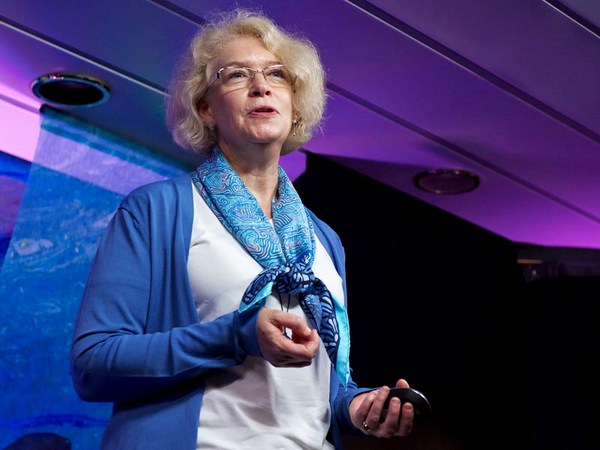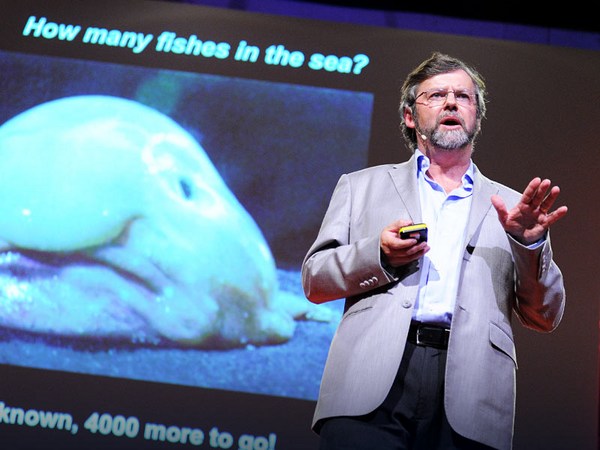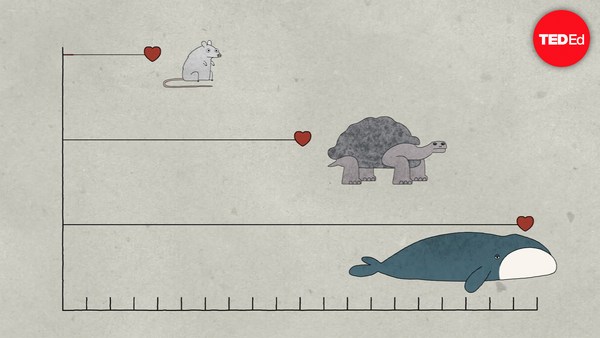If you’ve ever had an X-ray, ultrasound, CT or MRI performed, you may have experienced the unique feeling of looking at your body from the inside. It’s so strange to see a part of yourself that you’re both intimately familiar with and yet have never seen. Those images are created with a variety of techniques using sound waves and radiation and magnets. But for simplicity's sake, let’s envision them each as tiny pixels that come together to give us a picture that gives us a deeper meaning about our bodies. These images are not just for human bodies. They're also revolutionizing conservation. I’m a marine mammal veterinarian, and you and I are going to follow the path of a pixel to see how this work is changing the way that we treat wildlife and care for our natural world. Let’s start in California in the United States with a sea lion named Cronutt. Cronutt suffered brain damage and developed epilepsy after being exposed to domoic acid, which is a biotoxin that’s naturally produced by marine algae. Toxin producing algal blooms are becoming more frequent and more persistent as our ocean warms from climate change, affecting both mammals like Cronutt and humans alike. After multiple attempts at rehabilitation and clearly unable to survive on his own in the wild, Cronutt went to live at Six Flags Discovery Kingdom, where they managed his epilepsy with medication. Our brains have nerve cells, or neurons. Some excite and others inhibit or calm. In certain forms of epilepsy, the inhibitory neurons are lost, leading to the over-stimulated electrical activity of a seizure. The pixels in MRI images can show us where damage has occurred, where neurons are active, and even how different regions of the brain connects with one another. Dr. Scott Baraban’s lab at the University of California, San Francisco has been researching a new cell transplant therapy. He uses specialized cells that will turn into interneurons to replace the damaged cells with healthy ones. These special cells integrate into the circuitry of the brain and restore the calming function, effectively rewiring the brain and stopping seizures. Over time, Cronutt’s seizures and behavior changes got worse, and he was near death last year. He needed one last shot. An interdisciplinary team of 27 specialists from both the veterinary and human medical fields came together. We used both CT and MRI to highlight the portion of his brain called the hippocampus, which is shown in the MRI image on the left, outlined in the red box. These images guided neurosurgeons with a specially tailored needle to deposit the cells directly into the damaged site. Last October, Cronutt became the first sea lion ever to receive an interneuron transplant. And eight months later, we’re cautiously optimistic as he remains seizure-free. Let’s next follow the path of a pixel to Valencia, Spain. Dr. Daniel Garcia leads the veterinary team at Oceanographic, where they rehabilitate stranded sea turtles. Many of these turtles are bycaught, entangled in trawling nets and dragged up from the depths. Dr. Garcia’s team discovered by accident while treating turtle patients that sea turtles can get decompression sickness, or “the bends,” when nitrogen bubbles out of the blood during a rapid ascent to the surface. We used to think that sea turtles couldn’t get the bends, because of unique adaptations in their anatomy, physiology and behavior. These animals can stay underwater for up to seven hours at a time without getting decompression sickness. So what makes bycaught turtles different? But bycaught turtles are examined around the world, and these bubbles hadn’t been noted before, Dr Garcia’s team made the discovery thanks to collaborations. First, they developed strong collaborations with the fisherman who were accidentally catching the turtles. Instead of looking for bubbles inside of a long dead turtles, the fishermen gave the team almost immediate access to live turtles directly after they were caught. The fishermen also gave detailed observations describing a certain group of turtles that seemed fine but would later die several hours after being admitted for rehabilitation. The team also collaborated with human physicians to discover the disease. They use CT to pinpoint the gas bubbles and discover the damaged tissue around them. This CT image of the body of a sea turtle shows the lighter areas that are gas throughout the body of a turtle. And these aren't just tiny micro bubbles. I want you to fill your mouth up with air and really puff your cheeks out. That’s the total volume of nitrogen gas that might be found inside the body of a turtle, bubbles blocking blood vessels and cutting off oxygen to the brain, heart and beyond. The team also discovered a key to treatment. Like the treatment for humans, gas bubbles can diffuse back into the blood if the body’s re-pressurized. They first developed a crude decompression chamber out of an autoclave. And the result is just how I would imagine we would send a sea turtle to space. Over a decade, the team and the clinic refined their techniques to include a full-size hyperbaric chamber that was originally designed to treat human scuba divers with the bends. And now the rate of recovery and release for animals that arrive at the clinic alive is now 95 percent successful. These advanced imaging techniques are also revolutionizing marine mammal medicine in Hong Kong. Dr. Brian Cot, originally trained as a diagnostic radiographer, learning his expertise in imaging, like CT and MRI, that was originally designed to treat human patients, He recognized that the value could be applied to marine animals as well. And he now leads the virtopsy, or virtual autopsy, project, with the cetacean stranding response program in Hong Kong. A body that washes up, dead on the beach, can still provide a wealth of information. Post-mortem exams typically open the carcass and examine the organs in a systematic way. It’s a treasure hunt, and important things can be missed, particularly if the body is very decomposed. Virtopsy combines CT and MRI to give a guide to pathologists before they even start their exam, which improves their accuracy. Tiny lesions that might have been missed with routine sampling are pinpointed for a thorough exam. Two-dimensional images can be combined into 3D renderings. These groups of pixels are particularly effective for identifying lesions in bone or gas bubbles like we saw in the turtles in Valencia or identifying trauma to organs, and it’s safer. Because the carcasses are neatly wrapped, the risk to rescuers of catching a zoonotic disease spread from an animal is much lower. Dr. Cot is based at the City University of Hong Kong, and his team includes both human and veterinary radiologists, veterinarians, technicians and pathologists. The project is a collaboration between government, academia, aquaria and non-governmental foundations. Over the past six years, 240 marine animals were stranded along Hong Kong waters, and virtopsy was performed on 74 percent of them. That’s virtually every animal that could be safely retrieved. All of this incredible work is happening simultaneously all around the world. All of it includes advanced imaging that we couldn’t have imagined a century ago to peer deep within the body. And it’s happening while the threats we face and our collective human impact on the world is accelerating. I’m often asked, “Why?” Why spend the money or the resources to treat a single sea lion or rehabilitate a few sea turtles? I’m a veterinarian, and I took an oath to improve individual animal welfare and relieve suffering. And for Cronutt and those sea turtles, these procedures saved their lives and made all the difference. But some critics say that treating individual animals is not enough, and they’re absolutely right, that in the big picture, the individual impact is minimal. When we’re tackling the big conservation issues we face, treating single animals should be our last resort. It's not realistic on a large scale. Brain surgery will not be the answer for the majority of brain damaged wild sea lions. Decompression chambers won’t be the option for the majority of bycaught sea turtles. Few of the animals that strand around the world will pass through a CT before their body is examined, and the majority will never be examined at all. If we base our actions only on the patients in front of us and on our individual impact, then that impact will remain minimal. We have to think of our actions outside of the scope of individual impact and larger than ourselves. Consider all of the ways that this work does help more animals and different species. A first example is that sea lions, like Cronutt, are helping humans today and will continue to help them in the future. Biotoxins, like domoic acid, are a growing threat to both human and animal health. They are a key example of the direct effect that climate change is having on our health. And decades of research on domoic acid in sea lions has led to collaborations where the public health department uses reports of seizing sea lions to better target their toxin sampling and protect human health. Cronutt himself is charismatic, and his story may bring a glimmer of hope to someone with a pet or a loved one with epilepsy. His procedure can be refined to help other sea lions. And although not a reality today, treating Cronutt advances this type of cell transplant therapy towards one day helping humans with incurable epilepsy. A second example is that complex discoveries can lead to accessible conservation solutions. Discovering decompression sickness in turtles gave us direct clues on how to minimize the disease’s effects - no CT or decompression chamber needed. We learned that if trawling times are less than an hour, the risk of decompression sickness is very small. If turtle excluder devices are used, the risk is very small. These devices allow turtles to exit trawling nets through a specialized escape hatch. And for parts of the world where rehabilitation is not an option, releasing otherwise unharmed animals back into the water as quickly as possible may help the animals to naturally decompress themselves. Discovering decompression sickness required complex tools, but the solutions that arose are accessible for all. A third example is that this type of work is leading to direct conservation support around the world. As our technology advances, we have an even larger responsibility to use it for the benefit of all. Virtopsy makes exams easier, faster and safer, and it stores massive amounts of pixels. These images preserve the exam indefinitely. Now reaching out across the world for a second opinion becomes possible and easier; studies, over time, become more robust. Imagine the difference between studying a three-dimensional image like this one compared with studying a photograph of a bone. Two vulnerable Indo-Pacific species live in Hong Kong waters, the finless porpoise and the humpback dolphin. For finless porpoise, relatively little is known about this species in regions such as India or the Persian Gulf. Detailed virtopsy findings in Hong Kong can be combined with surveys of where these animals live and how they use their habitat to provide experts with a complete picture on how to best protect them. For humpback dolphins, they live close to shore lines throughout their range, and these shorelines are exactly where the majority of our human impacts happen. Understanding what human caused trauma, such as entanglement or ship strike, looks like in the body of an Indo-Pacific humpback dolphin can help responders recognize the trauma in similar species, such as a critically endangered Atlantic humpback dolphin. When we have a sick patient in front of us, time is of the essence. It’s of the essence for us, for wildlife species, for our ocean and for the most important patient that any of us will ever see: our planet. We must use these technologies and innovations to take ourselves outside of the stretches of our imagination. We must take these moonshots. And yet equally as importantly, we must transform the lessons that arise from these complex procedures into actions that are accessible for all. So the next time that you see an amazing image, a captivating group of pixels, remember that the healing impact can extend far beyond a single patient. Thank you.





